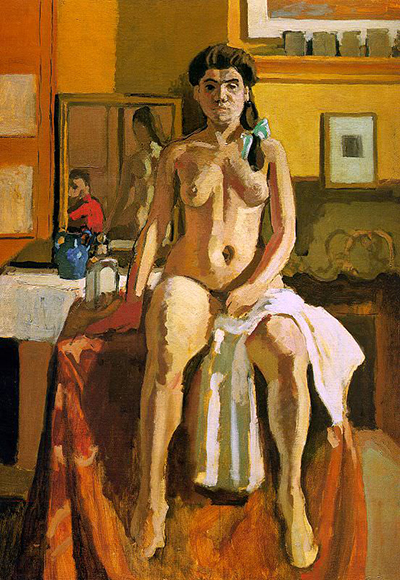Henri Matisse created Carmelina in 1903. The oil on canvas painting shows a nude woman sitting on a table. Matisse celebrated the female body in various pieces of art during his lifetime, including in sculpture and painting.
This painting in 1903 was made at the completion of Henri’s study of art and sculpture and ushered him to post-impressionism type of art. It is currently held at the Museum of Fine Arts in Boston, USA. In this painting, Henri plays with light, shadow and background to create a realistic feel of a seductive woman sitting in front of the viewer. The nude subject looks relaxed with a seductive grin on her face. She has long hair with a white haircloth. The table she sits on is draped in brown cloth. She has thrown a white cloth around her loins. The light plays in be giving her skin tone a vibrant tone, while a shadow on her left shows the viewers the source of the light.
Interestingly, the artist has captured other items in the room, including a bottle behind the model and a blue jar in the back left. There is a mirror behind the model. Henri uses it to show the backside of the model and a reflection of himself. Henri wears a red top and is seen sited in the reflection. The wall on the background has rectangular shapes with contrasting colours, and there is a framed image on the right. The fireplace is also visible on the right.
The Style of the Masterpiece
Henri used the Post-impressionism style in creating this masterpiece. The difference between impressionism and post-impressionism was the rendering of light and colour. Impressionist artists avoided the spontaneous show of light and a deliberate mix of colours in their art pieces. However, post-impressionist artists looked for ways to make their paintings as natural as possible.
By allowing artists to play with colour and light, post-impressionism removed the artificiality in art and gave it a more naturalistic feel. The light and colour are also key in sending emotional signals to the views. Additionally, the colour gives the images an aesthetic feel and contributes to the overall attractiveness of the picture.
In addition to light and colour, Matisse creates depth by expertly placing items around the room in comparative sizes compared to the main subject. His artistic demeanour comes into play with the addition of a mirror at the left corner of the image. This painting was an opening chapter of his post-impressionist life of refined art pieces. He indeed inspired later artists like Alan Bowness and John Layman.




